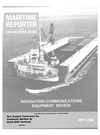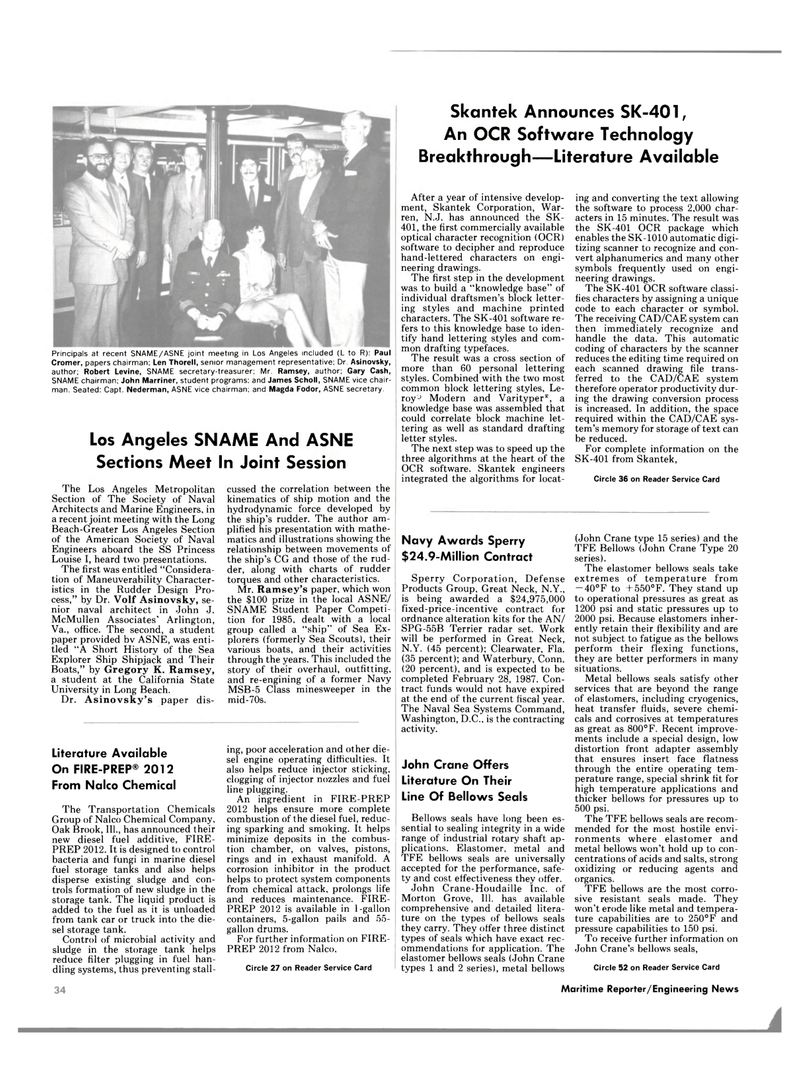
Page 34: of Maritime Reporter Magazine (May 15, 1985)
Read this page in Pdf, Flash or Html5 edition of May 15, 1985 Maritime Reporter Magazine
Principals at recent SNAME/ASNE joint meeting in Los Angeles included (L to R): Paul
Cromer, papers chairman; Len Thorell, senior management representative; Dr. Asinovsky, author; Robert Levine, SNAME secretary-treasurer; Mr. Ramsey, author; Gary Cash,
SNAME chairman; John Marriner, student programs: and James Scholl, SNAME vice chair- man. Seated: Capt. Nederman, ASNE vice chairman; and Magda Fodor, ASNE secretary.
Los Angeles SNAME And ASNE
Sections Meet In Joint Session
The Los Angeles Metropolitan
Section of The Society of Naval
Architects and Marine Engineers, in a recent joint meeting with the Long
Beach-Greater Los Angeles Section of the American Society of Naval
Engineers aboard the SS Princess
Louise I, heard two presentations.
The first was entitled "Considera- tion of Maneuverability Character- istics in the Rudder Design Pro- cess," by Dr. Volf Asinovsky, se- nior naval architect in -John J.
McMullen Associates' Arlington,
Va., office. The second, a student paper provided bv ASNE, was enti- tled "A Short History of the Sea
Explorer Ship Shipjack and Their
Boats," by Gregory K. Ramsey, a student at the California State
University in Long Beach.
Dr. Asinovsky's paper dis- cussed the correlation between the kinematics of ship motion and the hydrodynamic force developed by the ship's rudder. The author am- plified his presentation with mathe- matics and illustrations showing the relationship between movements of the ship's CG and those of the rud- der, along with charts of rudder torques and other characteristics.
Mr. Ramsey's paper, which won the $100 prize in the local ASNE/
SNAME Student Paper Competi- tion for 1985, dealt with a local group called a "ship" of Sea Ex- plorers (formerly Sea Scouts), their various boats, and their activities through the years. This included the story of their overhaul, outfitting, and re-engining of a former Navy
MSB-5 Class minesweeper in the mid-70s.
Literature Available
On FIRE-PREP® 2012
From Nalco Chemical
The Transportation Chemicals
Group of Nalco Chemical Company,
Oak Brook, 111., has announced their new diesel fuel additive, FIRE-
PREP 2012. It is designed to control bacteria and fungi in marine diesel fuel storage tanks and also helps disperse existing sludge and con- trols formation of new sludge in the storage tank. The liquid product is added to the fuel as it is unloaded from tank car or truck into the die- sel storage tank.
Control of microbial activity and sludge in the storage tank helps reduce filter plugging in fuel han- dling systems, thus preventing stall- ing, poor acceleration and other die- sel engine operating difficulties. It also helps reduce injector sticking, clogging of injector nozzles and fuel line plugging.
An ingredient in FIRE-PREP 2012 helps ensure more complete combustion of the diesel fuel, reduc- ing sparking and smoking. It helps minimize deposits in the combus- tion chamber, on valves, pistons, rings and in exhaust manifold. A corrosion inhibitor in the product helps to protect system components from chemical attack, prolongs life and reduces maintenance. FIRE-
PREP 2012 is available in l-gallon containers, 5-gallon pails and 55- gallon drums.
For further information on FIRE-
PREP 2012 from Nalco,
Circle 27 on Reader Service Card
Skantek Announces SK-401,
An OCR Software Technology
Breakthrough—Literature Available
After a year of intensive develop- ment, Skantek Corporation, War- ren, N.J. has announced the SK- 401, the first commercially available optical character recognition (OCR) software to decipher and reproduce hand-lettered characters on engi- neering drawings.
The first step in the development was to build a "knowledge base" of individual draftsmen's block letter- ing styles and machine printed characters. The SK-401 software re- fers to this knowledge base to iden- tify hand lettering styles and com- mon drafting typefaces.
The result was a cross section of more than 60 personal lettering styles. Combined with the two most common block lettering styles, Le- roy~ Modern and VarityperB, a knowledge base was assembled that could correlate block machine let- tering as well as standard drafting letter styles.
The next step was to speed up the three algorithms at the heart of the
OCR software. Skantek engineers integrated the algorithms for locat- ing and converting the text allowing the software to process 2,000 char- acters in 15 minutes. The result was the SK-401^ OCR package which enables the SK-1010 automatic digi- tizing scanner to recognize and con- vert alphanumerics and many other symbols frequently used on engi- neering drawings.
The SK-401 OCR software classi- fies characters by assigning a unique code to each character or symbol.
The receiving CAD/CAE system can then immediately recognize and handle the data. This automatic coding of characters by the scanner reduces the editing time required on each scanned drawing file trans- ferred to the CAD/CAE system therefore operator productivity dur- ing the drawing conversion process is increased. In addition, the space required within the CAD/CAE sys- tem's memory for storage of text can be reduced.
For complete information on the
SK-401 from Skantek,
Circle 36 on Reader Service Card
Navy Awards Sperry $24.9-Million Contract
Sperry Corporation, Defense
Products Group, Great Neck, N.Y., is being awarded a $24,975,000 fixed-price-incentive contract for ordnance alteration kits for the AN/
SPG-55B Terrier radar set. Work will be performed in Great Neck,
N.Y. (45 percent); Clearwater, Fla. (35 percent); and Waterbury, Conn. (20 percent), and is expected to be completed February 28, 1987. Con- tract funds would not have expired at the end of the current fiscal year.
The Naval Sea Systems Command,
Washington, D.C., is the contracting activity.
John Crane Offers
Literature On Their
Line Of Bellows Seals
Bellows seals have long been es- sential to sealing integrity in a wide range of industrial rotary shaft ap- plications. Elastomer, metal and
TFE bellows seals are universally accepted for the performance, safe- ty and cost effectiveness they offer.
John Crane-Houdaille Inc. of
Morton Grove, 111. has available comprehensive and detailed litera- ture on the types of bellows seals they carry. They offer three distinct types of seals which have exact rec- ommendations for application. The elastomer bellows seals (John Crane types 1 and 2 series), metal bellows (John Crane tvpe 15 series) and the
TFE Bellows "(John Crane Type 20 series).
The elastomer bellows seals take extremes of temperature from — 40°F to +550°F. They stand up to operational pressures as great as 1200 psi and static pressures up to 2000 psi. Because elastomers inher- ently retain their flexibility and are not subject to fatigue as the bellows perform their flexing functions, they are better performers in many situations.
Metal bellows seals satisfy other services that are beyond the range of elastomers, including cryogenics, heat transfer fluids, severe chemi- cals and corrosives at temperatures as great as 800°F. Recent improve- ments include a special design, low distortion front adapter assembly that ensures insert face flatness through the entire operating tem- perature range, special shrink fit for high temperature applications and thicker bellows for pressures up to 500 psi.
The TFE bellows seals are recom- mended for the most hostile envi- ronments where elastomer and metal bellows won't hold up to con- centrations of acids and salts, strong oxidizing or reducing agents and organics.
TFE bellows are the most corro- sive resistant seals made. They won't erode like metal and tempera- ture capabilities are to 250°F and pressure capabilities to 150 psi.
To receive further information on
John Crane's bellows seals,
Circle 52 on Reader Service Card 36 Maritime Reporter/Engineering News

 33
33

 35
35
